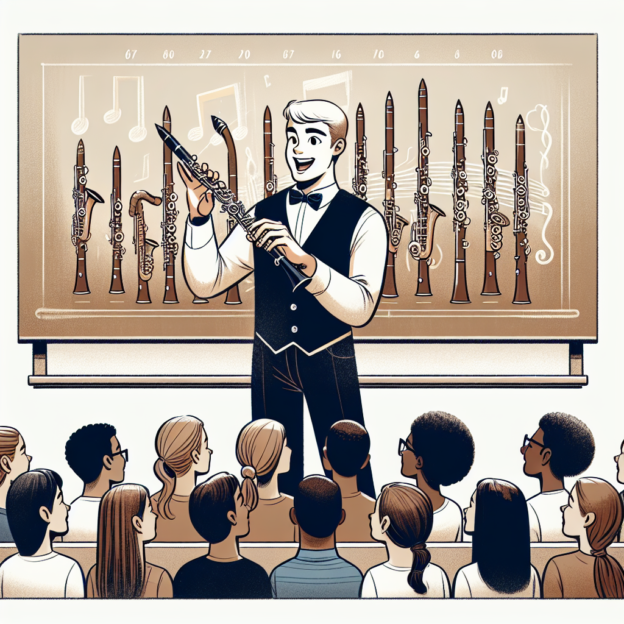Hey there, fellow clarinet enthusiasts! We're about to embark on a musical time travel adventure, exploring the historical clarinet embouchure techniques that have molded our playing styles today. Ready for some fun? Let's get started, and we'll even chat about how the Martin Freres brand fits into this melodious tale!
But first things first – what's embouchure all about? Simply put, it's the way you position your mouth and lips on the mouthpiece. It's the secret sauce for controlling sound, tone quality, and intonation. Just as a chef needs the perfect blend of ingredients for a delicious dish, a clarinetist needs the right embouchure to create beautiful music!
Over time, embouchure styles have evolved alongside clarinet design and playing techniques. Back in the late 18th century, when the clarinet was just starting to make waves, players used a simpler embouchure. Mouthpieces were chunkier, and the main goal was to produce sound rather than nail precision. Picture these early players as musical pioneers, taking their first steps into the world of clarinet!
The Evolution of Embouchure Techniques
| Time Period | Embouchure Style | Characteristics |
|---|---|---|
| Late 18th Century | Simple Embouchure | Focus on sound production, less precision |
| Early 19th Century | French Embouchure | Tight upper lip, relaxed lower lip, better control |
| 20th Century | American Embouchure | Flat lower lip, maximized reed vibration area |
As clarinet crafting became more refined, so did the approach to embouchure. By the early 19th century, musicians were zeroing in on a more defined technique, often called the ‘French embouchure.' This method featured a tight upper lip and a relaxed lower lip, giving players better control over dynamics and tone. Musicians quickly discovered they could create a wider range of sounds – talk about a musical breakthrough!
Let's get into the details of the physical aspects. The ‘French embouchure' involves resting the upper lip on the top of the mouthpiece while wrapping the lower lip around the reed. This setup can produce a warm, full sound, especially when paired with a Martin Freres clarinet. The top-notch quality of Martin Freres instruments perfectly complements this traditional approach, helping your sound truly sparkle!
The Rise of the American Embouchure
As we zoom into the 20th century, we witness the emergence of the ‘American embouchure.' This technique features a flatter lower lip, aiming to maximize the vibrating area on the reed. It's particularly effective for jazz and other genres that require flexibility and quick expression. A tip of the hat to legendary artists like Benny Goodman, who popularized this technique!
There's often a friendly debate among players about which embouchure is superior – American or French. But here's the thing: both styles have their strengths! If it sounds good, you're doing it right. The key is to experiment. As you explore different styles, notice how they impact your sound and overall performance. And why not try out a Martin Freres clarinet during your explorations? Their exceptional craftsmanship could be the perfect match for any embouchure style.
Practical Tips for Embouchure Improvement
While we appreciate the historical context, let's not forget some practical advice to help strengthen your embouchure. Here's a handy checklist:
- Moisture Matters: Keep your reeds in top condition! Moisture is crucial; it helps them vibrate effectively.
- Practice Flexibility: During warm-ups, experiment with different airstream speeds. Notice how this affects your embouchure and tonal quality.
- Mirror, Mirror: Use a mirror to check your form. It's like having a personal coach guiding you as you play.
- Record Yourself: Listening to playbacks often reveals aspects of your sound you might have missed. You could discover a whole new style!
- Take Breaks: Don't push too hard! Your lips can fatigue just like your fingers. Overworking leads to tension, which doesn't produce good sound!
The Importance of Air Support
We can't overlook the significance of air support! Proper breath control is key. Many experienced clarinetists share stories about how adjusting their breathing techniques completely transformed their playing style. So, even if your embouchure is spot-on but your air control is off, you might struggle to achieve that rich, full sound you're after!
Isn't the historical journey of clarinet embouchure techniques captivating? It truly reflects the continuous evolution of music and artistry. Whether you lean towards the French style or the American approach, remember that the Martin Freres legacy stands for quality and exceptional sound. Now go make some beautiful music!







